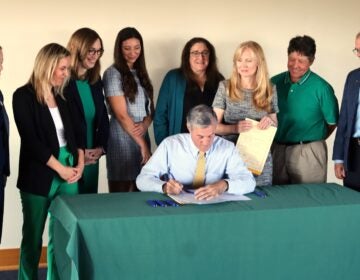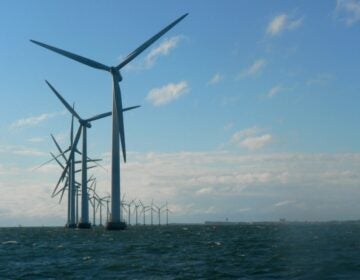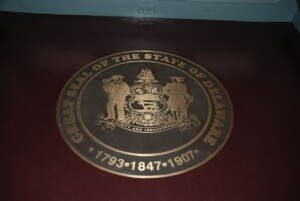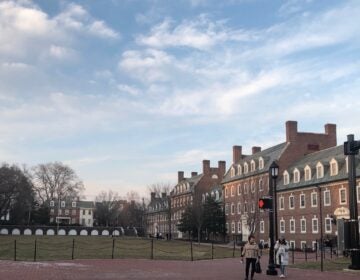Conservative Delaware think tank sues to stop Maryland offshore wind farm
Up to four power cables from offshore wind turbines will be buried under Delaware wetlands and beaches. Some fishermen worry about harm to wildlife.
Listen 0:55
(U.S. Wind/Twitter)
From Philly and the Pa. suburbs to South Jersey and Delaware, what would you like WHYY News to cover? Let us know!
This story was supported by a statehouse coverage grant from the Corporation for Public Broadcasting.
A lawsuit filed in Delaware’s Superior Court on Monday aims to stop electric cables from being buried under Delaware-controlled waters and coastline for a controversial offshore wind project.
US Wind’s Maryland Offshore Wind Project off the Delmarva coast has proposed running power transmission cables from its wind farm three miles offshore in the Atlantic Ocean to 3Rs Beach at Delaware Seashore State Park. The cables would run beneath Delaware-regulated wetlands, state waters and the Indian River Bay and connect to a substation near a former power plant.
Gov. John Carney announced the start of formal negotiations with US Wind late last year, with the company proposing to lease the cable landing at 3Rs Beach for $350,000 a year with annual increases. Delaware would also get $76 million in renewable energy credits and $40 million for the community benefits projects over 20 years.
Former judge and GOP party chair Jane Brady filed the case on behalf of the Caesar Rodney Institute, a Delaware think tank that has connections to the fossil fuel industry and has promoted misinformation about the connection between offshore wind and whale deaths. The suit also names two commercial fishermen as plaintiffs — Wes Townsend and George Merrick.
The lawsuit contends the permit applications for the project are incomplete because of a missing report from the Division of Watershed Stewardship and the lack of a zoning permit for the substation. The suit asks the court to forbid the state from allowing the project to proceed.
Townsend said he’s bringing legal action because he’s worried about the impacts to the bay.
“All the recreational crabbing, clamming, fishing, riding around in general in the bay and the risk of this cable coming in and we have no idea what it’s going to do to marine life,” he said. “It’s the most used bay that we have. We just can’t risk it.”
US Wind declined to comment on the lawsuit.
The cables are expected to be buried about 40-feet deep under Route 1 and about 60-feet beneath the beach and dunes, according to public documents released by the Delaware Department of Natural Resources and Environmental Control. The company needs DNREC to approve three permits: a subaqueous lands permit, a wetlands permit and a beach preservation coastal construction permit.
A timeline of the project from a July 5 information session shows DNREC Secretary Shawn Garvin is expected to make a decision on the permits by the end of the year.
The lawsuit criticizes DNREC’s permitting process, arguing that despite each permit being governed by specific regulatory criteria, DNREC decided to consider all permits in one “joint” application process and only provided one public information session July 9. DNREC’s public comment period on all of the permits ended Sept. 9. Brady said that because the applications are incomplete, the public was unable to provide informed comments on the project.
Townsend said the cables could have a negative effect on the wildlife in the bay, impacting his ability to make a living. While no cables have yet been put in place in Delaware, he argues other installations have impacted marine life.
“They’re already starting to show things now where the electric currents coming off the cable are starting to affect crab larvae and everything else,” he said. “In the winter time, the female crabs go down to the lower end of the bay and they bury down in the mud. That’s how they survive the winter. So we don’t know what that’s going to do.”
Sussex County has yet to decide on whether to grant a conditional use permit for the project. Renewable Redevelopment, a subsidiary of US Wind, asked the county council for a permit to build the large electric substation.
Brady argued that the council could stop the project in its current form by not approving a conditional use permit.
“There’s a law that says the state can’t override the county,” she said. They’ve given the authority to the county to decide zoning issues, and so they can’t then disregard or override the county’s decision. That’s the county’s sovereign choice, and so if the county says no, then US Wind is back at the drawing board figuring out what they’re going to do.”
The council deferred making a decision this summer and a spokesperson said no vote is currently scheduled. It declined to comment on the lawsuit.
“It was pretty clear that most of the council was openly opposed to rezoning because Sussex County gets no electricity guaranteed out of this. They get no jobs guaranteed out of this,” Brady said. “The authority to grant a conditional use is for the convenience and benefit of Sussex Countians, and there is none in this project.”
The Maryland US Off Wind project has said it will generate enough electricity to power 718,000 homes in that state.
The Bureau of Ocean Energy Management recently announced it is seeking public comment for a possible second commercial wind energy project in the Central Atlantic, which is more than 13 million acres located off the coasts of New Jersey, Delaware, Maryland, Virginia and North Carolina.
WHYY is your source for fact-based, in-depth journalism and information. As a nonprofit organization, we rely on financial support from readers like you. Please give today.








